Related Research Articles
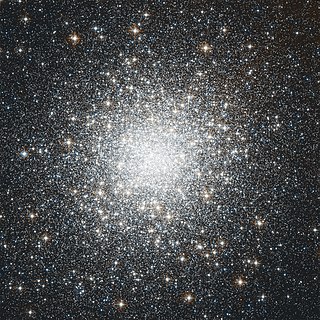
A globular cluster is a spheroidal conglomeration of stars that is bound together by gravity, with a higher concentration of stars towards its center. It can contain anywhere from tens of thousands to many millions of member stars, all orbiting in a stable, compact formation. Globular clusters are similar in form to dwarf spheroidal galaxies, and though globular clusters were long held to be the more luminous of the two, discoveries of outliers had made the distinction between the two less clear by the early 21st century. Their name is derived from Latin globulus. Globular clusters are occasionally known simply as "globulars".

Star clusters are large groups of stars held together by self-gravitation. Two main types of star clusters can be distinguished. Globular clusters are tight groups of ten thousand to millions of old stars which are gravitationally bound. Open clusters are more loosely clustered groups of stars, generally containing fewer than a few hundred members, that are often very young. As they move through the galaxy, over time, open clusters become disrupted by the gravitational influence of giant molecular clouds. Even though they are no longer gravitationally bound, they will continue to move in broadly the same direction through space and are then known as stellar associations, sometimes referred to as moving groups.
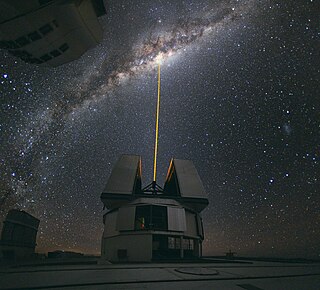
Astronomy is a natural science that studies celestial objects and the phenomena that occur in the cosmos. It uses mathematics, physics, and chemistry in order to explain their origin and their overall evolution. Objects of interest include planets, moons, stars, nebulae, galaxies, meteoroids, asteroids, and comets. Relevant phenomena include supernova explosions, gamma ray bursts, quasars, blazars, pulsars, and cosmic microwave background radiation. More generally, astronomy studies everything that originates beyond Earth's atmosphere. Cosmology is a branch of astronomy that studies the universe as a whole.
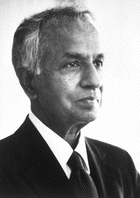
Subrahmanyan Chandrasekhar was an Indian-American theoretical physicist who made significant contributions to the scientific knowledge about the structure of stars, stellar evolution and black holes. He was awarded the 1983 Nobel Prize in physics along with William A. Fowler for theoretical studies of the physical processes of importance to the structure and evolution of the stars. His mathematical treatment of stellar evolution yielded many of the current theoretical models of the later evolutionary stages of massive stars and black holes. Many concepts, institutions and inventions, including the Chandrasekhar limit and the Chandra X-Ray Observatory, are named after him.

Astrophysics is a science that employs the methods and principles of physics and chemistry in the study of astronomical objects and phenomena. As one of the founders of the discipline, James Keeler, said, astrophysics "seeks to ascertain the nature of the heavenly bodies, rather than their positions or motions in space—what they are, rather than where they are", which is studied in celestial mechanics.

Donald Lynden-Bell CBE FRS was a British theoretical astrophysicist. He was the first to determine that galaxies contain supermassive black holes at their centres, and that such black holes power quasars. Lynden-Bell was President of the Royal Astronomical Society (1985–1987) and received numerous awards for his work, including the inaugural Kavli Prize for Astrophysics. He worked at the University of Cambridge for his entire career, where he was the first director of its Institute of Astronomy.
Michel Hénon was a French mathematician and astronomer. He worked for a long time at the Nice Observatory.

The Institute of Astronomy (IoA) is the largest of the three astronomy departments in the University of Cambridge, and one of the largest astronomy sites in the United Kingdom. Around 180 academics, postdocs, visitors and assistant staff work at the department.
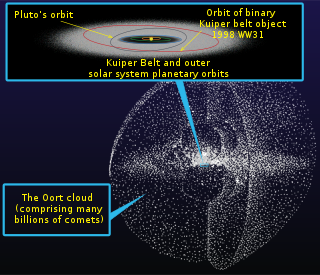
Theoretical astronomy is the use of analytical and computational models based on principles from physics and chemistry to describe and explain astronomical objects and astronomical phenomena. Theorists in astronomy endeavor to create theoretical models and from the results predict observational consequences of those models. The observation of a phenomenon predicted by a model allows astronomers to select between several alternate or conflicting models as the one best able to describe the phenomena.

The following outline is provided as an overview of and topical guide to astronomy:

The Astronomical Calculation Institute is a research institute in Heidelberg, Germany, with origins dating back from the 1700s. Beginning in 2005, the ARI became part of the Center for Astronomy at Heidelberg University. Previously, the institute directly belonged to the state of Baden-Württemberg.

Kenneth Charles Freeman is an Australian astronomer and astrophysicist who is currently Duffield Professor of Astronomy in the Research School of Astronomy and Astrophysics at the Mount Stromlo Observatory of the Australian National University in Canberra. He was born in Perth, Western Australia in 1940, studied mathematics and physics at the University of Western Australia, and graduated with first class honours in applied mathematics in 1962. He then went to Cambridge University for postgraduate work in theoretical astrophysics with Leon Mestel and Donald Lynden-Bell, and completed his doctorate in 1965. Following a postdoctoral appointment at the University of Texas with Gérard de Vaucouleurs, and a research fellowship at Trinity College, Cambridge, he returned to Australia in 1967 as a Queen Elizabeth Fellow at Mount Stromlo. Apart from a year in the Kapteyn Institute in Groningen in 1976 and some occasional absences overseas, he has been at Mount Stromlo ever since.
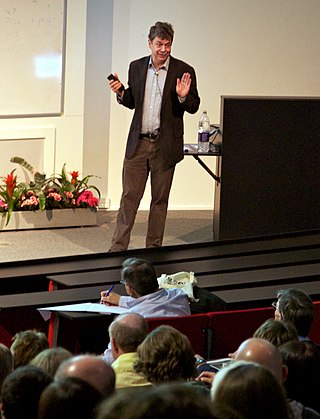
Simon David Manton White, FRS, is a British-German astrophysicist. He was one of directors at the Max Planck Institute for Astrophysics before his retirement in late 2019.

Piet Hut is a Dutch astrophysicist, who divides his time between research in computer simulations of dense stellar systems and broadly interdisciplinary collaborations, ranging from other fields in natural science to computer science, cognitive psychology and philosophy.
N-body units are a completely self-contained system of units used for N-body simulations of self-gravitating systems in astrophysics. In this system, the base physical units are chosen so that the total mass, M, the gravitational constant, G, and the virial radius, R, are normalized. The underlying assumption is that the system of N objects (stars) satisfies the virial theorem. The consequence of standard N-body units is that the velocity dispersion of the system, v, is and that the dynamical or crossing time, t, is . The use of standard N-body units was advocated by Michel Hénon in 1971. Early adopters of this system of units included H. Cohn in 1979 and D. Heggie and R. Mathieu in 1986. At the conference MODEST14 in 2014, D. Heggie proposed that the community abandon the name "N-body units" and replace it with the name "Hénon units" to commemorate the originator.

Computational astrophysics refers to the methods and computing tools developed and used in astrophysics research. Like computational chemistry or computational physics, it is both a specific branch of theoretical astrophysics and an interdisciplinary field relying on computer science, mathematics, and wider physics. Computational astrophysics is most often studied through an applied mathematics or astrophysics programme at PhD level.
Shashikumar Madhusudan Chitre FNA, FASc, FNASc, FRAS was an Indian mathematician and astrophysicist, known for his research in Astronomy and Astrophysics. The Government of India honored him, in 2012, with Padma Bhushan, the third highest civilian award, for his services to the sciences.

Georges Meylan is a Swiss astronomer, born on July 31, 1950, in Lausanne, Switzerland. He was the director of the Laboratory of Astrophysics of the Swiss Federal Institute of Technology (EPFL) in Lausanne, Switzerland, and now a professor emeritus of astrophysics and cosmology at EPFL. He is still active in both research and teaching.

Conny Clara Aerts, born 26 January 1966, is a Belgian (Flemish) professor in astrophysics. She specialises in asteroseismology. She is associated with KU Leuven and Radboud University, where she leads the Chair in the Astroseismology group. In 2012, she became the first woman to be awarded the Francqui Prize in the category of Science & Technology. In 2022, she became the third woman to be awarded the Kavli Prize in Astrophysics for her work in asteroseismology.
In cosmology, Gurzadyan-Savvidy (GS) relaxation is a theory developed by Vahe Gurzadyan and George Savvidy to explain the relaxation over time of the dynamics of N-body gravitating systems such as star clusters and galaxies. Stellar systems observed in the Universe – globular clusters and elliptical galaxies – reveal their relaxed state reflected in the high degree of regularity of some of their physical characteristics such as surface luminosity, velocity dispersion, geometric shapes, etc. The basic mechanism of relaxation of stellar systems has been considered the 2-body encounters, to lead to the observed fine-grained equilibrium. The coarse-grained phase of evolution of gravitating systems is described by violent relaxation developed by Donald Lynden-Bell. The 2-body mechanism of relaxation is known in plasma physics. The difficulties with description of collective effects in N-body gravitating systems arise due to the long-range character of gravitational interaction, as distinct of plasma where due to two different signs of charges the Debye screening takes place. The 2-body relaxation mechanism e.g. for elliptical galaxies predicts around years i.e. time scales exceeding the age of the Universe. The problem of relaxation and evolution of stellar systems and the role of collective effects are studied by various techniques, see. Among the efficient methods of study of N-body gravitating systems are the numerical simulations, particularly, Sverre Aarseth's N-body codes are widely used.
References
- ↑ Heggie, D. C. (1 December 1975). "Binary evolution in stellar dynamics". Monthly Notices of the Royal Astronomical Society. 173 (3): 729–787. Bibcode:1975MNRAS.173..729H. doi: 10.1093/mnras/173.3.729 .
- ↑ "The Gravitational Million-Body Problem: A Multidisciplinary Approach to Star Cluster Dynamics". Cambridge University Press.
- ↑ Heggie, D. C. (1981). Megalithic Science: Ancient Mathematics and Astronomy in North-west Europe: Douglas C. Heggie: 9780500272114: Amazon.com: Books. Thames and Hudson. ISBN 0500272115.
- ↑ "George Heriot's School Captains and Duces". george-heriots.com. Archived from the original on 15 February 2019. Retrieved 15 February 2019.
- ↑ "IAS Visiting Scholars". www.ias.edu. 9 December 2019.
- ↑ "Invited Speakers – ANZIAM 2014". anziam2014.auckland.ac.nz.
- ↑ "IAU Commission 37: "Star Clusters and Associations" (Triennium 1985–1988)". iau.org.
- ↑ "Pioneering physicist and galaxy luminary among 2025 RAS award winners". www.ras.ac.uk. Retrieved 19 January 2025.